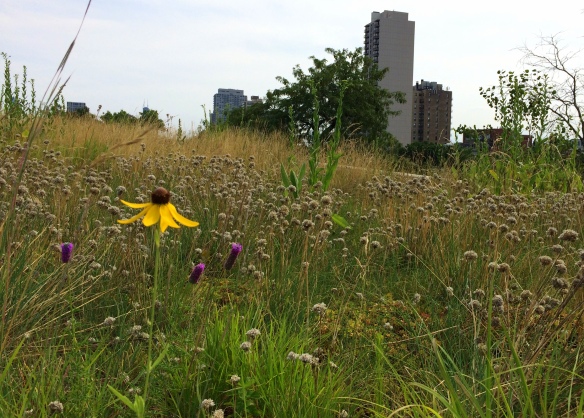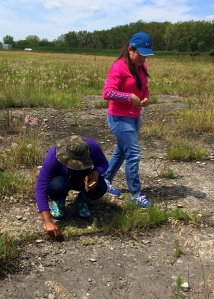Once again, August was a busy month, filled with field work, lab work and even a conference! It’s fun to look back and see what I was able to accomplish.

One lonely pinnate prairie coneflower blooms in my green roof prairie plot. It’s trying to attract some pollinators – go little coneflower, go!
The month started with completion of the vegetation surveys that I was conducting on 3 of the green roofs in the Chicago area. These vegetation surveys allow me to measure the height, coverage and reproduction ability of the various plants that I planted on the green roof. With the rainy summer we’ve been having in Chicago, most of the plants are doing quite well and my little plots continue to look like mini-prairies. Originally, August was supposed to be the last time that I had to take these measurements. But my mini-prairies are looking so good (and I’m such a botanist!) that I want to come back next year and measure them again. We’ll see if that’s still the plan come 2016.
Speaking of prairies, I also visited an actual prairie for my research (on the ground this time, as opposed to a rooftop). Two interns from the Chicago Botanic Garden and I took a trip to a large prairie in central Illinois to collect leaf tissue from the same species of plant that I’m studying on the roofs. I am looking at how pollen movement in this species can help increase the genetic diversity of green roof populations. But I wanted to know what the genetic diversity of this species is like in natural populations, in real prairies. So we collected leaf tissue from a natural population, extracted the DNA from the leaf cells, and are now working in the lab to measure the diversity. This is a work in progress, so stay tuned for the results. If anything, it was neat to see the plant species I’m working with in its natural habitat.

Interns from the Chicago Botanic Garden help me collect leaf samples from the natural prairie population.
In addition to collecting lots of data, I was also fortunate to be asked to present some of the overall findings of my research so far. I’m still working on collecting some more data from internet sources and analyzing my results but I am beginning to find some trends with the data that I collected back on the green roofs in Germany in 2013. It seems like there are very few patterns that predict which plant species colonize green roofs and survive on them over time. It looks like each green roof is a unique place with its own community of plants and animals that live there. I was able to share these results (and others) at a special green roof session of the Ecological Society of America’s annual meeting in Baltimore, MD. And not only did I get to present my research, but I got to attend lectures and workshops where I learned about other people’s research too. It was a busy week in Baltimore and even though I came back tired, I was also inspired and excited to keep making discoveries with my own research.

The hotel at the Baltimore Convention Center had a green roof. A great inspiration view as I prepared to give a presentation about my green roof research at the ESA conference.
And finally, in August I started to work in the lab again to continue work that I’ve been doing for about a year now. The lab was super busy with summer interns but toward the end of the month things quieted down a bit and I could claim some work space back. I’m ready to continue the work I was doing back in the spring. It’s time to find out if I can determine the father plants of all the seeds that I collected last fall and grew up into little seedlings over the winter. It’s going to be a lot of work but I’m looking forward to being a bit of a botanical detective!


So each green roof is like a Pacific island, where the species that end up there are essentially isolated from other forces? Does this mean there are few birds and pollinators visiting, which would increase the diversity?
LikeLiked by 1 person
Well, I’m not entirely sure yet and will be doing a lot more work to try and find out. Some species are really good at spreading their seeds and pollen among the green roof “islands” while others are not so good. (Think about dandelions – their wind-borne seeds get just about everywhere – these are the types of species that are good at colonizing green roofs. Other species that have seeds that just fall to the ground do not seem to be spread between roofs.)
Even though the green roofs get visited by some birds and pollinators, the diversity is typically lower than what you’d find in the same location, but on the ground. So for now it looks like your’re right about the lack of birds and pollinators being seen with low plant diversity on the green roofs.
Thanks for the comments!
LikeLike